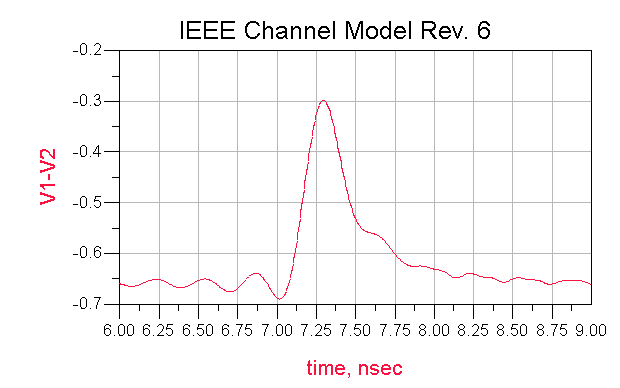Re: [BP] how to evaluate signaling method follow up
Mike
Attach is the pulse response I get for the IEEE thru_rev5 model, I was
referring to the ripple prior to
main pulse.
Thanks,
Ali
Mellitz, Richard wrote:
>I added the shell for package modeling that I've been using for some
>time now. I just call it the spec package models that I use to driver
>real design requirement. I just tuned the models to -10dB for the 5GHz
>and under mark. It's under 100 MB too :-)
>
>Anyhow it's a 3 differential line model and assumes the die resistance
>and capacitance load are parameters in the die model outside of this
>package model.
>
>
>PS, Oh Charles,
>Neat hspice tricks! It addresses channel jitter amplification.
>
>
>-----Original Message-----
>From: owner-stds-802-3-blade@listserv.ieee.org
>[mailto:owner-stds-802-3-blade@listserv.ieee.org] On Behalf Of Charles
>Moore
>Sent: Wednesday, September 01, 2004 7:23 PM
>To: STDS-802-3-BLADE@listserv.ieee.org
>Subject: [BP] how to evaluate signaling method follow up
>
>
>guys,
>
> Here is the next step after the proposal i sent out August 23.
>
> This includes:
>
> 1. A simulation file for NRZ simulation.
>
> 2. A transmitter subcircuit file for NRZ simulation.
>
> 3. A simulation file for PAM4 simulation.
>
> 4. A transmitter subcircuit file for PAM4 simulation.
>
> 5. a zip file with the PRBS pwl files i used.
>
> You can look at the files to see the structure of the simulation or
>use them to do simulations yourself. If you want to do simulations
>you will need:
>
> 1. A receiver subcircuit file named "rx.inc". I am treating
> receivers as proprietary.
>
> 2. Package model subcircuit files for the transmitter called:
> "TxPackage.inc" and for the receiver called: "RxPackage.inc"
>
> 3. A touchstone file describing the channel. You may need to
> change the name of the file in the simulation file.
>
> You may want to change the parameter values in the simulation file.
>The tap values i have included give fairly good EYEs with Steve
>Anderson's thru6 channel and the stresses nearly or just re-close the
>EYE.
>
> The over all structure of the simulation deck for either is:
>
> The simulation file includes:
>
> 1. Parameter values, which are in 3 kinds:
> A. Transmitter definition parameter:
> i. baud, baud rate: 10.3125G for NRZ or 5.15625G for PAM4
> ii. Amp, the nominal peak to peak differential amplitude
> iii. Trf, the trapezoidal rise and fall time in UI
> B. Transmitter peaking parameters:
> i. 1 Precursor and 1 postcursor tap value for NRZ
> ii. 2 Postcursor tap values for PAM4
> C. Stress parameters:
> i. XtalkAmp, interference amplitude (half peak to peak)
> ii. XtalkFratio, ratio of interference frequency to
> baud rate.
> iii. TJ, total jitter in UI
> iv. dutyCycle_over_TJ, fraction of total jitter which is
> at half baud rate
> 2. Transmitter sub circuit. The transmitter sub circuit implements
> a 3 tap equalizer and includes parameterized jitter.
> 3. Package models. I am going to ask that someone else find a
> suitable model.
> 4. The channel.
> 5. Receiver load (the Tx load is included in the subcircuit)
> 6. Interference injection sources.
> 7. An instance of the receiver sub circuit. Someone else should
> provide the receiver model. It may be encrypted. The Out
> port or the MSB and LSB ports should be considered the
> final measurement point.
>
> If we decide to proceed with this approach the following will need
>to be done before going too much farther:
>
> 1. Define standard values for Transmitter definition parameters
> and targets for Stress parameters. These may be different for
> the 3 (or more) signaling schemes.
> 2. Find a set of channels to simulate over.
> 3. Write scripts for analyzing the output including finding
> EYE size if that is relevant and checking for correct data.
> 4. Write scripts which pre-code PRBS data for duo-binary or
> write output analysis script to post-decode the data.
> 5. Generate longer data files for more through testing. The
> included scripts should be good enough for finding the right
> equalizer settings etc. but we will want longer more complex
> patterns for final evaluation.
> 6. Separate out all the parts of the simulation file which are
> design values (like tap values) from the specified parts, and
> put them in an include file.
> 7. Fix the various problems which the ad-hoc will discover for
> me.
>
> charles
>
>
>
>|--------------------------------------------------------------------|
>| Charles Moore
>| Agilent Technologies
>| ASIC Products Division
>| charles_moore@agilent.com
>| (970) 288-4561
>|--------------------------------------------------------------------|
>
>

begin:vcard
fn:Ali Ghiasi
n:Ghiasi;Ali
org:Broadcom
adr;dom:;;3151 Zanker Road;San Jose;CA;95134
email;internet:aghiasi@broadcom.com
title:Chief Architect
tel;work:(408)922-7423
tel;cell:(949)290-8103
url:http://www.broadcom.com
version:2.1
end:vcard
